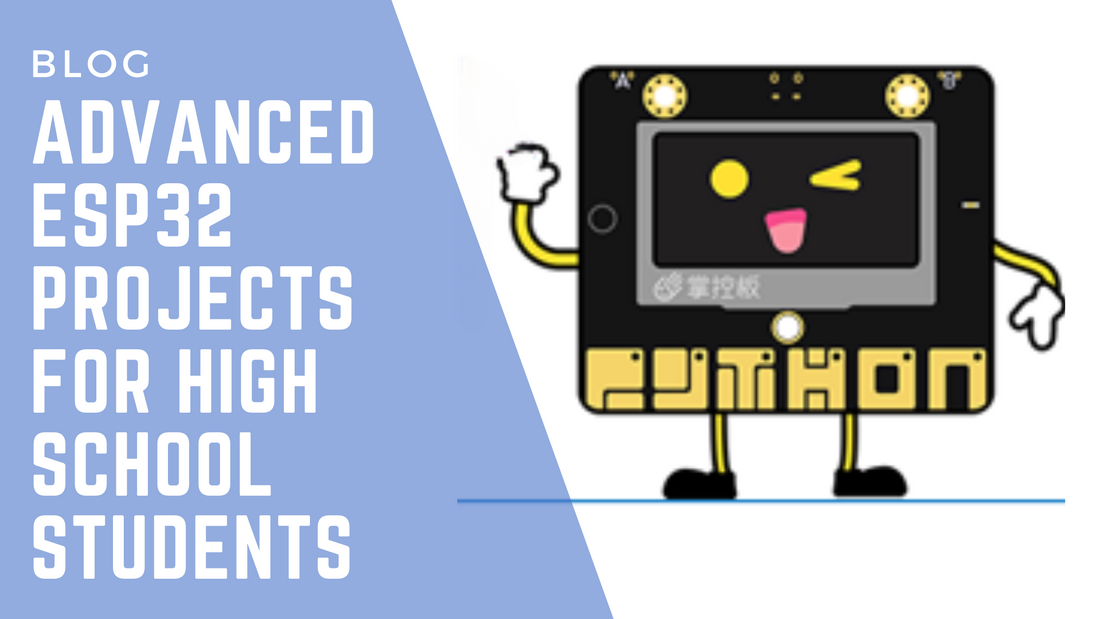
Advanced ESP32 Projects for High School Students
The ESP32 is a powerful microcontroller that can take high school students' understanding of coding, electronics, and the Internet of Things (IoT) to the next level. By this stage, students have likely mastered basic projects such as blinking LEDs or controlling simple sensors. Now, it’s time to challenge them with more advanced projects that tap into the ESP32’s full potential.
In this blog, we’ll explore five advanced ESP32 projects designed specifically for high school students. These projects will deepen their understanding of IoT, robotics, Bluetooth programming, and home automation, and help them develop practical, real-world skills.
1. Build a Line-Following Robot
Project Overview: A line-following robot is a great way to introduce students to advanced robotics. Using infrared (IR) sensors, students can program an ESP32-powered robot to follow a designated path. This project teaches critical coding concepts like conditional logic and motor control, while also giving students hands-on experience with hardware.
Steps:
- Attach two IR sensors to the front of the robot.
- Connect two motors to control the robot’s movement.
- Write code that reads sensor input and adjusts the robot’s direction to follow a black line on a white surface.
Key Learning Points:
- Sensor input: Students learn how to process sensor data and convert it into meaningful actions.
- Motor control: The project introduces the concept of pulse width modulation (PWM) for smooth motor control.
- Conditional logic: Students implement if-else statements to navigate the robot along the path.
Extensions:
- Add a third IR sensor for better accuracy.
- Introduce a timer to measure how fast the robot can complete a course.
2. Create a Bluetooth-Controlled car
Project Overview: Building a car using the ESP32 combines electronics, and coding into one exciting project. High school students can learn how to control a car using a second ESP32 via Bluetooth communication. This project also introduces key concepts in wireless programming and real-time control.
Steps:
- Build a simple car using the STEAM Starter Kit
- Set up Bluetooth communication between two mpythonboard
- Write code that allows students to control the car movement using directional input from a 2nd mpythonboard.
Key Learning Points:
- Wireless communication: Students explore the fundamentals of Bluetooth and how devices interact with each other wirelessly.
- Real-time control: Coding for real-time responses is crucial for controlling the drone’s movement.
- Physics of flight: Students can learn about basic aerodynamics, such as lift and thrust, and how motor speed affects flight.
Extensions:
- Add a gyroscope to learn about turning.
- Include line sensor functionality to allow the car to follow predetermined paths.
3. Build a Home Automation System with Voice Control
Project Overview: In this advanced project, students can create their own smart home automation system. They’ll use the ESP32 to control appliances such as lights, fans, or alarms using voice commands through Google Assistant or Amazon Alexa. This project introduces IoT, cloud integration, and natural language processing concepts.
Steps:
- Connect mpythonboard to Neo Pixel module.
- Set up the ESP32 to interact with Blynk, enabling in extention.
- Write code that enables the mpythonboard to respond to voice commands.
Key Learning Points:
- IoT integration: Students learn how to connect devices to the cloud and control them remotely.
- API programming: Introduces students to RESTful APIs and how to send/receive data between devices.
- Voice control: Students explore voice recognition and how virtual assistants interpret and respond to commands.
Extensions:
- Add more smart devices (e.g., security cameras or smart locks).
- Implement machine learning algorithms to predict user behavior and automate tasks based on routines.
4. Build a Wi-Fi Weather Station with Data Logging
Project Overview: In this project, students create an advanced weather station that measures temperature, humidity, and air quality. Using the ESP32’s built-in Wi-Fi, the data is uploaded to the cloud for real-time monitoring. Students can analyze the data and even build a dashboard to visualize trends over time.
Steps:
- Connect temperature and humidity sensor to the mpythonboard.
- Write code to collect and process sensor data.
- Use a platform like ThingSpeak or Google Sheets to log the data and create visualizations.
Key Learning Points:
- Data logging: Students learn how to send data from sensors to a cloud service and store it for analysis.
- Real-time data visualisation: This project helps students understand how to display data using graphs and charts in real time.
- Wireless communication: Students use the mpythonboard’s Wi-Fi capabilities to connect to cloud services and interact with data remotely.
Extensions:
- Add additional sensors to monitor air pressure using Air Pressure module .
- Build a mobile app that displays weather data in real time.
5. IoT-Based Home Security System
Project Overview: A home security system project challenges students to use the ESP32’s Wi-Fi and sensor capabilities to build a system that monitors doors, windows, or motion and sends alerts to a smartphone. This project combines hardware (e.g., motion sensors, cameras) and software (e.g., sending SMS alerts) to create a real-world solution.
Steps:
- Connect PIR motion sensors and door/window sensors to the ESP32.
- Write code to monitor sensor data and trigger alerts when motion is detected or a door/window is opened.
- Use IR communication to send messages between two boards.
Key Learning Points:
- Sensor integration: Students learn how to integrate multiple sensors into a single system and process their input.
- Cloud-based notifications: They gain hands-on experience with sending data from IoT devices to the cloud for monitoring and alert systems.
- Security principles: Students can explore basic encryption and secure communication to protect the data transmitted by their system.
Extensions:
- Add AI camera module to take photos or video when motion is detected.
- Implement facial recognition using OpenCV or a machine learning library.
Why Advanced mpythonboard Projects Matter for High School Students
These advanced projects are more than just technical exercises — they prepare high school students for future careers in engineering, computer science, and IoT. Here’s why these projects are so important:
- Real-World Applications: Students get to build solutions to real-world problems, from home automation to data logging, giving them a deeper understanding of how technology impacts our everyday lives.
- Critical Thinking: Advanced projects challenge students to problem-solve, debug code, and think creatively about how to improve their designs.
- Cross-Disciplinary Learning: ESP32 projects often combine several areas of learning, from physics (e.g., aerodynamics in drone projects) to math (e.g., data analysis in weather stations), providing a well-rounded educational experience.
- Teamwork and Collaboration: These projects encourage group work and collaboration, helping students develop communication and project management skills crucial for STEM careers.
Final Thoughts
The ESP32 is a versatile microcontroller that offers countless opportunities for high school students to explore advanced technology. Whether building robots, designing IoT systems, or creating home automation solutions, these projects empower students to take their coding and electronics skills to the next level.
By integrating these projects into your curriculum, you not only provide students with hands-on experience but also help them develop the critical thinking, problem-solving, and technical skills they’ll need in their future careers. As students tackle these advanced challenges, they’ll gain confidence in their abilities to create innovative solutions that have real-world impact.
So, encourage your students to dive into these advanced mpythonboard projects — and watch them transform into the tech innovators of tomorrow!
